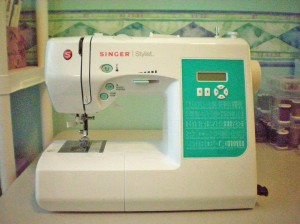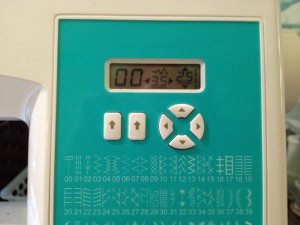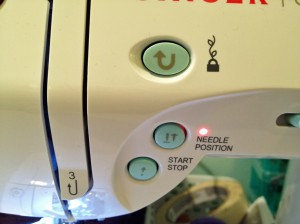Monday’s Mish-Mash: Switching to a Computerized Sewing Machine
For years, I had a regular sewing machine. You know, the kind with knobs and dials to adjust the tension and stitches. It was very basic, but quite a workhorse. I used it for nine years without a tuneup and it had no problems, right up until the day the timing died. (See the blog post: When an Old Friend Bites the Dust.) I replaced it with a computerized Singer Stylist, which handles very differently. It took me weeks to get used to the differences!
I would compare the old Brother to a car with a manual transmission, while the new Singer is like an automatic. For one thing, there are fewer knobs and dials. Instead, there are automated push-buttons. You tap a button and the computer makes the necessary adjustments for you. You can even sew without touching the foot pedal, just by pressing a button.
Quirks
When you first turn the sewing machine on, it lights up and, for some reason, the needle jerks from side to side. I really dislike the fact that the machine doesn’t save your settings when you turn it off. If you’re working on a project that requires a particular stitch length and width, you’ll need to write those numbers down, because it when you turn the machine back on, it will have automatically defaulted to the factory settings. I don’t know if this is normal for all computerized machines, but it’s annoying.
The “feel” of the machine is different from what I was used to with a regular machine. With a mechanical sewing machine, you press on the foot pedal, and slowly the engine begins to engage. You can ease into it as slowly as you like, and the harder you press, the faster you go. If you don’t press hard enough to begin with, the engine will stall and you’ll have to let your foot up and try again.
With the computerized machine, basically, it’s either on or off. There is no easing into it and the engine never stalls. You press the pedal and when it reaches a certain point—you’re on. You can adjust the maximum stitching speed, so that no matter how hard you stomp on the pedal, it remains slow and steady. This is a nice feature for beginners who might be intimidated by a fast machine.
It can be unnerving to ease up on the pedal, only to have it completely cut off. With my old machine, I could ease off and let the machine slow down, but with the computerized machine, there is no such thing. You let your foot ease past a certain point and the engine quits. This gets frustrating if you’re trying to slow down to ease around a curve, for instance.
Buttons
The backstitch feature takes some getting used to. When you press the button, it continues forward for a single stitch, then goes backwards for as long as you hold the button down. When you release the button, it takes one more backwards stitch, then resumes going forward. You must take this into account, so you don’t accidentally sew off the edge of your fabric.
You also have to be careful not to release the button before you’re ready to stop backstitching. If you let go of the button and let your foot off the pedal, it resets and will refuse to continue backstitching unless you go forward again, first.
One feature I really love is the automatic needle position. With a traditional machine, when you stop, the needle stops wherever it was when you took your foot off the pedal, whether that’s up, down, or halfway in between. With my new machine, the needle automatically rises when you stop sewing. Or, if you prefer, you can change it so it stops with the needle down in the fabric. This is useful if you’re sewing a tricky seam or working with slippery fabrics and you don’t want the fabric to shift every time you stop sewing.
Overall, I like using the computerized sewing machine. It does take time to get used to the differences, but it’s (mostly) worth the frustration.
~~*~~
Is your sewing machine mechanical or computerized? Which do you prefer? Do you have any tips on getting the most out of your machine?




2 Responses to Switching to a Computerized Sewing Machine